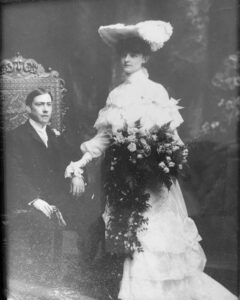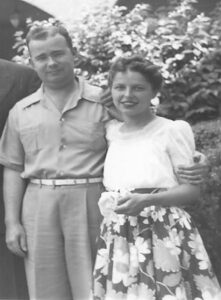 If Grandma or Great Aunt Maude are constantly reminiscing about the good old days, why not preserve their stories for your children? Every family should have an oral history tape library right next to the family picture album. Starting such a collection is easy to do with an inexpensive tape recorder. (Yes, tape recorders are having a rebirth but for more modern techniques, we have included them in this article.)
If Grandma or Great Aunt Maude are constantly reminiscing about the good old days, why not preserve their stories for your children? Every family should have an oral history tape library right next to the family picture album. Starting such a collection is easy to do with an inexpensive tape recorder. (Yes, tape recorders are having a rebirth but for more modern techniques, we have included them in this article.) First, sit down and write out a one-page summary of what you want to find out from Grandma. There are two basic ways to approach the oral history interview: chronological and topical. Try the chronological one first because it is the easiest. Start out with such questions as: “Where were you born?” “Who were your parents?” and “Where did you go to school?” As you go through your grandmother’s life, you may hit upon the interesting fact that she played a part in some major event in history. If not, you may have to do some research before going on. Go to your library and read up on American and local history to find out what happened during your grandparents’ lifetimes. Then find out what they remember about these events.
For the topical approach, prepare a list of questions about a certain subject. Or you can ask how she, as a young housewife, got and prepared the family’s food. Did she work outside the family home? What did she do?
If you are inteviewing your grandfather, you can ask him about his military service. Did he take part in the labor movement? If he was a farmer, what methods did he use to plant and harvest his crops?
Ask questions that need more than “yes” or “no” answers.
 Try to get the reminiscences flowing. One way to give memories a nudge is to pass around old photographs and ask questions about them. Try to go with the flow. Do not brow-beat your relatives by asking such leading questions as “You do remember when the woolen mill burnt down, don’t you?”
Try to get the reminiscences flowing. One way to give memories a nudge is to pass around old photographs and ask questions about them. Try to go with the flow. Do not brow-beat your relatives by asking such leading questions as “You do remember when the woolen mill burnt down, don’t you?” In the past, having the proper equipment is important. Cassette tape recorders are easier to use than reel-to-reel. A built-in microphone is easier to set up and will be less distracting for anyone who suffers from mike fright. A digital counter will be helpful when you want to index or transcribe the tapes. A pause button also will be helpful when you index and transcribe.
Today, of course, just using your cell phone to record your interviews is so easy. Then you can have your computer transcribe the interview so you can work from your computer before printing the final version. Make sure to keep a notebook handy to write down the correct spelling of names and places.
Modern Day Recording/Transcription
Special thanks to Krysti Joméi of Birdy Magazine for helping us update our information on how to preserve your family history. Below you will find the modern techniques.
Recording:
Apple devices (on iPhones/Macs): Voice Memo app comes with Apple products. But there’s several other recording apps out there you can purchase.
Android devices: I’m not sure about this one but I think Android devices come with Voice Recorder app. But again you can purchase tons of other apps for recording.
Zoom/Google Meet/Any other Video Meeting Programs have options to record the audio of the meeting or the actual video of the meeting
Professional reporters/podcasters may use different professional equipment instead of phones for clearer audio. I don’t know much about these devices but you could do a quick Google search to find out. Transcription:
AI (artificial intelligence) services/programs online for audio and video transcription. These services transcribe audio or video recordings, online interviews or meetings (like Zoom) or in person face-to-face interviews or meetings.
There’s also services online transcribed by real people versus AI. These programs can transcribe audio in different languages.
Basics of how they work: you upload your audio or video file into the program and it takes a few minutes to transcribe it into text which is downloadable into several different file types (PDF, Word, Pages, etc.). They’re highly accurate but you do need to go through and edit the transcription as there’s a few misspelled words, usually ones that are unusual like the name of a business or product, etc. I’ve also noticed these programs have a hard time differentiating between speakers so you usually need to edit who is speaking for interviews. Examples of programs are Trint, Notta AI, Otter AI, GoTranscript (you can find more if you just do a Google search for best audio transcription programs).
Back to our original article:
Choose a quiet place for your interviews and try to make your interview subject comfortable. Make sure that he or she knows that you are recording the conversation. If you are planning to interview more than one peson, do so one-at-a-time. You might be surprised at the different versions of what Grandma and Grandpa remember about their life together.
When you have finished your interview, identify it by its general topic, both the name of the person interviewed and the name of the person who did the interviewing, the date, the location, and the length of the tape. Then note the main topics covered in time segments by listening to the tape, using a stopwatch and writing down the main topic discussed in each 5 or 10 minute segment.
If you think that your family’s history may be of some interest outside your immediate family, you may want to give copies to your local library. Libraries today can take your document electronically which is the best way to save paper and space when sharing your family research. Be sure to get written permission from everyone you interviewed before you do this.
There are some books that you might want to read before starting your own oral history project.
An Oral History Primer by Gary Shumway and William Hartley (Primer Publications, P.O. Box 11894, Salt Lake City 84147) is a good guidebook for anyone who is just getting started in oral history.
Family Folklore: Interviewing Guide and Questionnaire (Washington D.C.; Smithsonian Institution) can be bought from the Consumer Information Center. Item 16P, Box 100, Pueblo, CO 81002) It contains a helpful list of questions to get your interview off to a good start.
The chapter “Historical Everyman” in David Weitzman’s Underfoot: An Everyday Guide to Exploring the American Past (New York: Charles Scribners and Sons) offers simple techniques for recording your family’s memories.















Follow Us